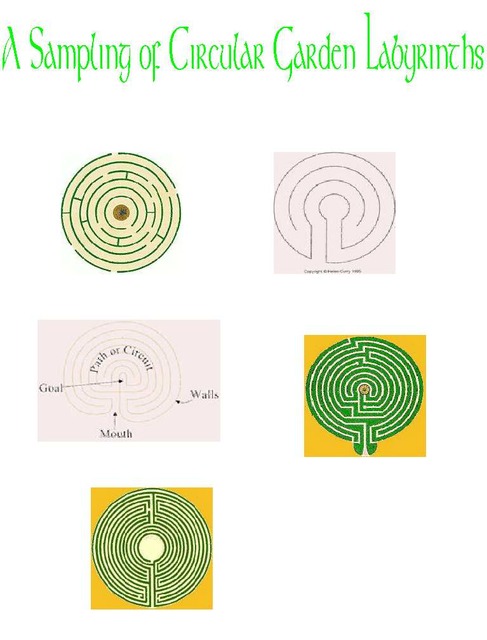Brooklyn Community Gardeners
Garden Mazes

a good basic article...
creating a garden maze and labyrinthsUniversity of Vermont Extension
Department of Plant and Soil Science
Summer Article
CREATING YOUR OWN GARDEN MAZE OR LABYRINTH
By Dr. Leonard Perry, Extension Professor
For an unusual and different garden feature, why not create a maze or labyrinth
in your own backyard? It's not hard to do, though it's a good idea to first
draw the outline on paper, regardless of the design or group of patterns you
choose. This can always be altered once you are outside to fit reality, as in
changing the design to match the radius of your mower.
Next you need to decide where to put your labyrinth or maze. The minimal
recommended space is at least 25 feet across although even a narrow rectangular
space might suffice. If you have limited space, you may only have the option of
orientation, perhaps facing the opening towards a hill, a view, noon sun
direction on the solstice, or compass direction.
Several materials can be used for mazes and labyrinths. A turf labyrinth, such
as the older ones found in England, often consist of mowed turf circles with
walking paths of gravel, mulch, or other material. Or you can mow the path and
allow the grass along the sides to grow tall. The circles can be geometrical or
more free form. This creates some larger spaces between the paths for
perennials and other plants.
Once, when I was visiting a castle garden in England, I saw people walking in
odd patterns on a lawn, as in some ritual. When I got closer, I discovered that
they were following stepping-stones laid in the lawn in a labyrinth pattern.
This is another variation of the turf type.
The most elaborate and fun maze that I've seen was at Hever Castle in England,
which also has a traditional hedge maze of yews as is common in that country.
The castle's splashing water maze has solid path segments to walk on over a pond
in order to get to the center. Along the way you may get splashed with various
jets of water depending on where you step!
If you have a narrow space, use posts and wire fencing to grow vines. This
also is perhaps the least expensive way to use plants, other than the straight
turf labyrinth, or a version using turf and plantings in wider areas. You might
use one type of vine or a mix of several types. If using several, just make
sure the vigorous ones don't overtake and kill the others.
Vigorous selections would include hops, bittersweet, sweet autumn clematis,
trumpetcreeper, hardy kiwi, Virginia creeper, and honeysuckles. In milder
climates of USDA zone 5 or warmer, consider grapes and wisteria. For annual
ornamental vines, try sweet peas, morning glories, or hyacinth beans. If you
use vegetable vines such as beans and peas trained on a fence, you could have a
maze or labyrinth and a garden, too!
If there's ample space with at least two to three feet between paths, you can
use stone walls or plants. When choosing materials, keep in mind the height
desired. For mazes, the challenge lies in solving the puzzle, so use taller
materials and plants to keep participants from seeing the whole picture or which
route to take. For labyrinths, it is the experience of going in and retracing
steps back out that is important, so these often use lower growing plants and
materials.
Generally, the space between paths is not very wide, so this rules out most
shrubs. However, some upright, columnar, and rather narrow cultivars of some
shrubs, such as junipers, may be suitable. Maze shrubs usually include the slow
growing yew, or the fast growing honeysuckle, which, as with any vigorous shrub,
will need a lot of pruning. Using all shrubs may be quite expensive as well.
Several ornamental grasses might work well, such as the switchgrass, feather
reed grass, or the eulalia. Depending on the cultivar, the latter may not be
hardy in zone 4. Some cultivars may be quite vigorous. Others in warm climates
may be seed invasive. Low grasses, such as blue fescue or sedges, could be used
to line paths. Ornamental grasses are fairly maintenance free, tough, and may
provide a fairly quick and more affordable alternative to shrubs.
Perennials generally are not used for labyrinths, as most will spread over time
and require more space. They could be used in corners or wider areas in
groupings. Or you might have paths lined with daylilies, tall garden phlox, or
other upright or clumping perennials if sufficient room.
Tall annuals for mazes include corn and sunflowers, which are probably the least
expensive and quickest plants to use. Annuals that clump may be used to line or
separate paths of a labyrinth. Common ones include marigolds, zinnias,
impatiens, and geraniums, among many more. If using annuals, especially if you
are creating an elaborate circular type labyrinth, one idea is to select flowers
the colors of the rainbow with a different color for each circular path.
Finally, in the center of the maze or labyrinth, consider leaving a quiet grassy
area to rest and meditate, perhaps with a bench or seat. Add garden statuary
and metal figures, such as garden fairies, angels, and spirit stakes in the
meditation area or along the path.
Whatever labyrinth or maze type you choose, it will need some maintenance. This
might be planting annual flowers, dividing perennials, pruning shrubs, mowing
turf, or trimming weeds between stepping-stones and stone walls.
For more information on labyrinth types, functions, and design, check out the
Labyrinth Society's Website at www.labyrinthsociety.org.
Email us
emilyholiday@gmail.com


